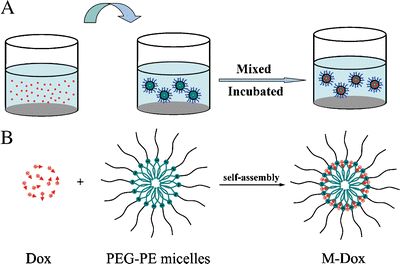Development of self-assembling nanocarriers for water-soluble drugs
Accurate targeting of anti-cancer therapeutic drugs is critical for their efficacy. While most chemotherapeutic drugs are active against intracellular targets, intracellular delivery at levels that are sufficient to inhibit tumor cell proliferation or kill tumor cells is challenging since many resistant tumor cells can pump drugs out of the cell through specific efflux mechanisms. Professor Wei Liang’s group has been addressing this problem by developing novel nano-sized drug delivery systems that can penetrate into the depths of tumor tissues and into tumor cells(http://www.springerlink.com/content/m8r07p5338685563/fulltext.html).
In their recent Pharmaceutical Research paper, Professor Liang’s group describes the structure and self-assembly mechanism of pegylated lipid micelles that encapsulate water-soluble drugs. Polyethylene glycol (PEG)-phosphatidylethanolamine (PE) micelles are known to be stable and to have a long-circulation time in the bloodstream. Their self-assembly, encapsulating water-soluble drugs such as doxorubicin hydrochloride, vinorelbine tartrate and vincristinesulfate, was investigated using dynamic light scattering, and transmission electron microscopy. An encapsulation efficiency and release study was conducted and NMR was used to study the molecular assembly of PEG-PE with doxorubicin. They report that doxorubicin hydrochloride and vinorelbine tartrate were entrapped into micelles with efficiencies of >99.0% at molar ratios of 1:1 and 2:1 of PEG-PE to drugs, respectively. Drug loading did not measurably perturb either the geometry or the size of the micelles. Electrostatic interactions and hydrophobic forces were found to be responsible for intercalation of the drugs into the PEG-PE micelles. NMR data revealed that the anthracycline ring of doxorubicin was inserted between PE phospholipids, and its amino sugar was located in the outer shell of the micelles between the PEG chains. Drugs loaded in these PEG-PE micelles demonstrated slow release. Both the sustained release and encapsulation efficiency of these two drugs encapsulated in PEG-PE micelles are a consequence of the hydrophobic interactions between the two hydrocarbon chains of PE and hydrophobic doxorubicin and vinorelbine.
A simple one-step self-assembly method which does not require the use of organic solvents was developed for preparing drug-loaded micelles with high drug encapsulation efficiency and controlled drug release. These findings will be useful for designing optimal drug nano-carriers for cancer therapy or other disease therapeutic applications.

Schematic illustration of the self-assembly of water-soluble drugs, such as doxorubicin hydrochloride, and PEG-PE in double-distilled water. (A) One-step self-assembly procedure. (B) Detailed structure of nano-assemblies of PEG-PE with water-soluble drugs.

